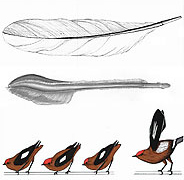Blog Archives
Virtuoso
Ornithologists at Cornell University were able to show that a bird from the rainforest, a club-winged manakin, made their mating sounds by rubbing their wings together! How cool is that? Really, it is cool. Watch the video and see below for an explanation.
Special thanks to my Mom for telling me about this little bird. Love you Mom!
This finch-sized bird just lifts its wings above its back. Big deal, right? That “lift” makes the noise. How? Slow motion video showed that the bird’s wings were a blur. This means that the bird was probably rubbing its wings together to make the sound. Dr. Kimberly Bostwick got herself a better digital video camera that could take 1000 frames per second. She finally was able to see the wing movement (you can too). It turns out that the bird is rubbing its wings together about 100 times a second. That is twice as fast as a humming bird.

The club-winged manakin uses a club-shaped feather as a pick to rake the ridges of another feather.
Illustration by Dr. Kimberly Bostwick
The frequency of the sound that was recorded was about 1400 hertz. That is quite a bit more than 100 hertz (wing beats per second). Dr. Bostwick was still missing a piece of the puzzle. She needed what she called a “frequency multiplier”. She looked more closely at the wing morphology of the bird. She found her frequency multiplier in the feathers. When the bird moves its wings, 2 special feathers rub together. See the illustration and caption on left for an explanation. The short answer is: cello and bow. One hundred times per SECOND. Beat that Yo Yo Mah!
These birds make the sound similar to the way crickets do. This shows that this type of sound making is not limited to insects, an amazing discovery. Evolution once again teaches us that no matter how much we may want to neatly put things in separate categories, life is just not that simple.
“…from so simple a beginning endless forms most beautiful and most wonderful have been, and are being, evolved.” Charles Darwin, last sentence from the Origin of Species.
If you’d like to see Dr. Bostwick’s journal article in Science, you can read it as a webpage or a pdf file.
